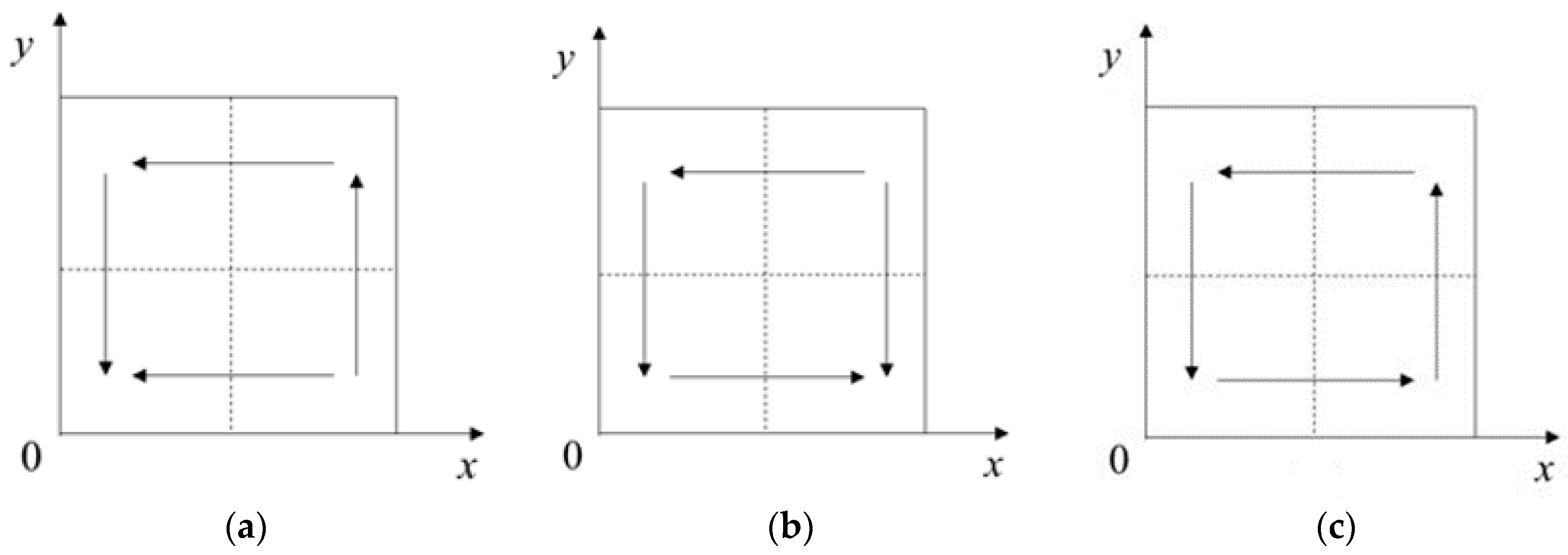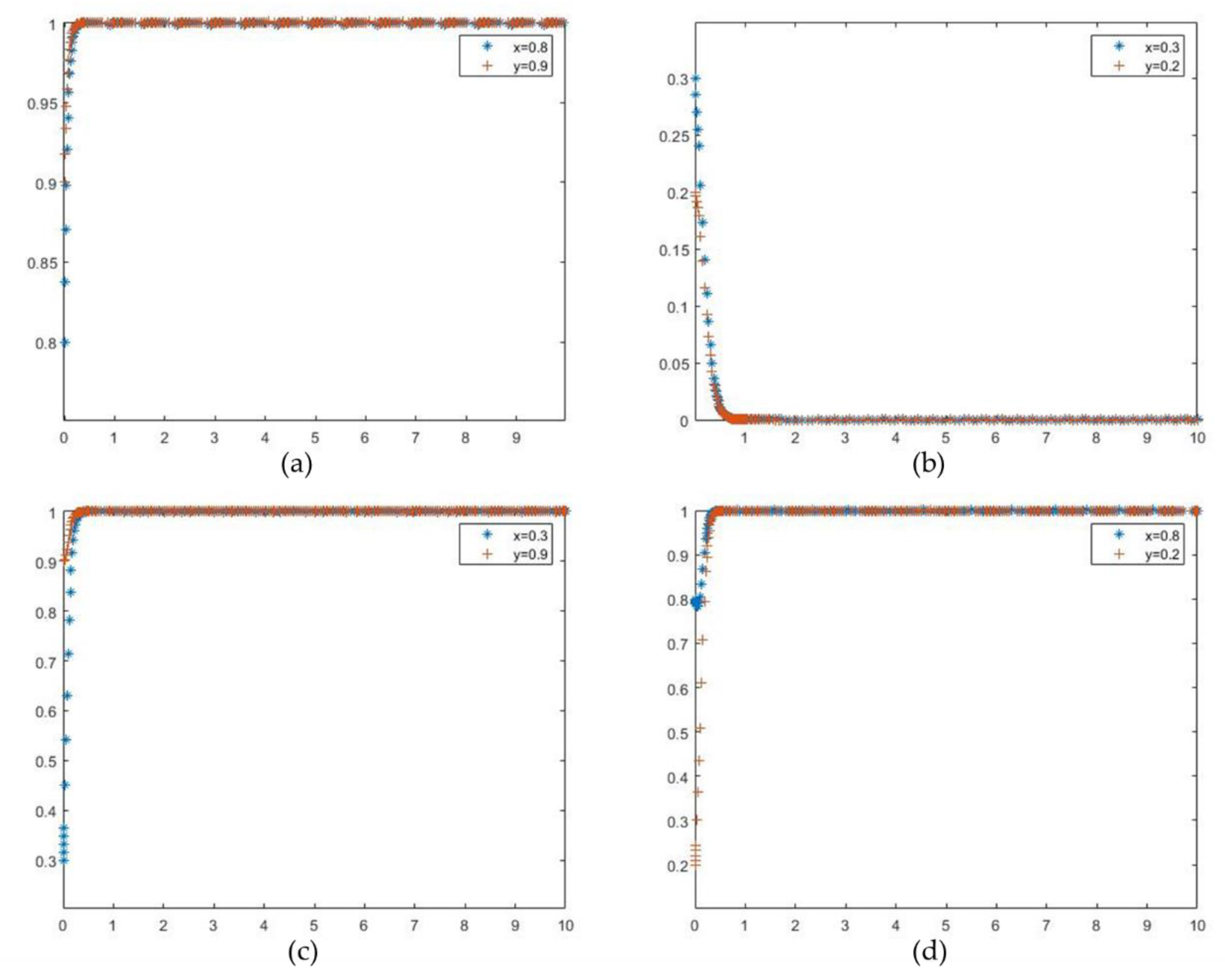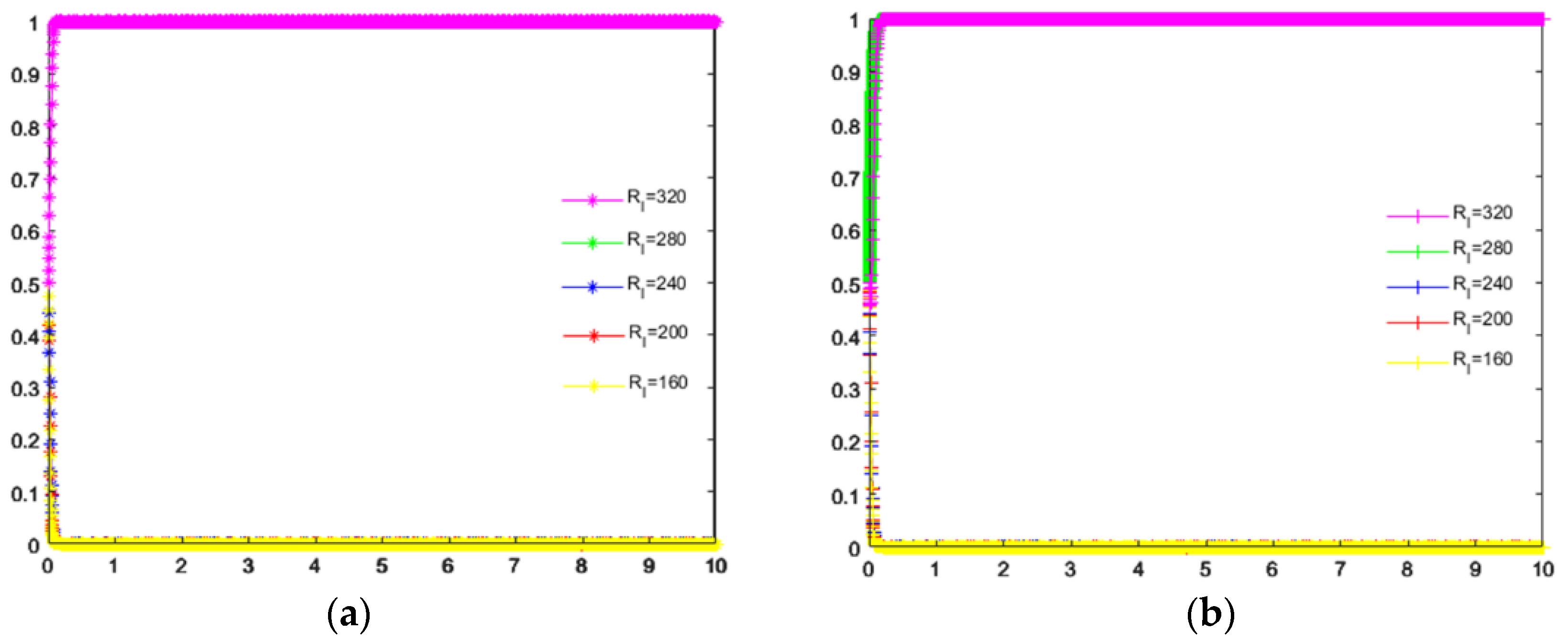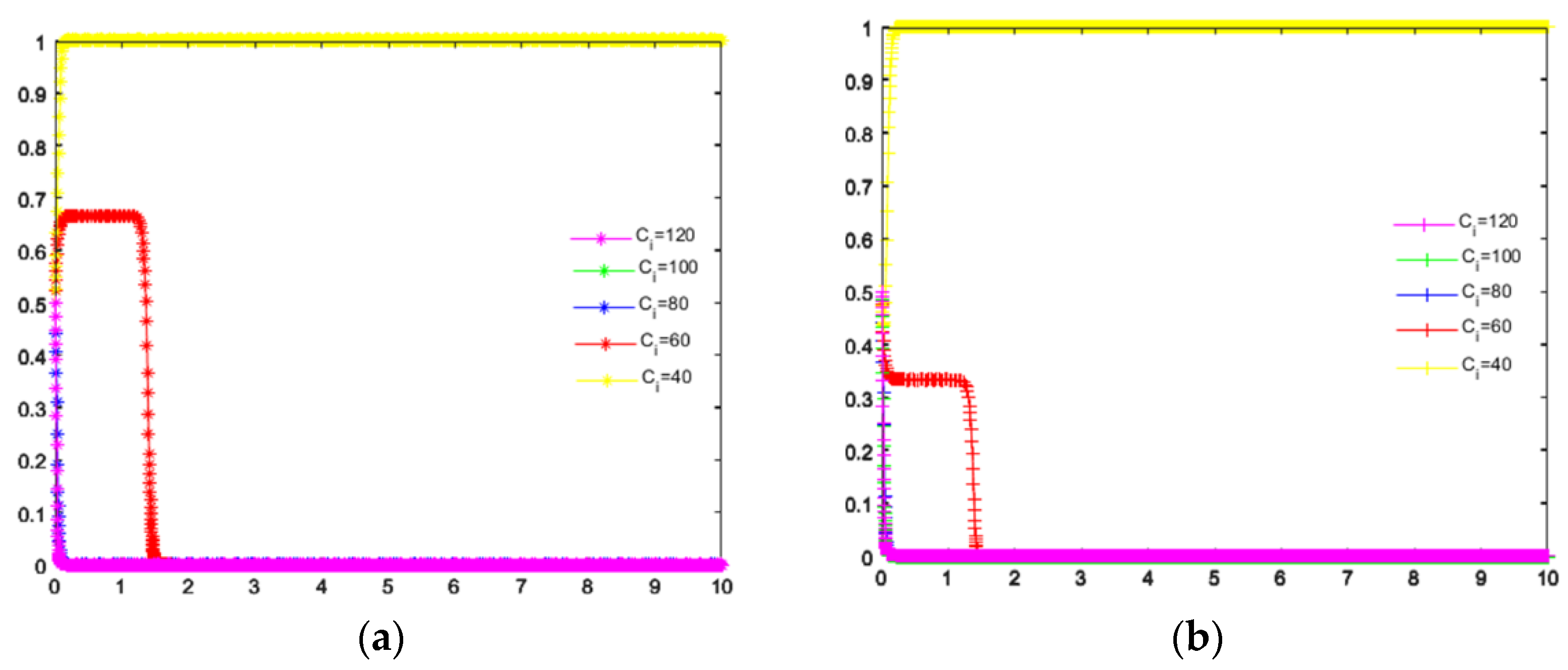1. Introduction
Tropical storm “Harvey” affected six million people in south Texas and disrupted traffic on the ground and in the air in 2017. In 2018, typhoon “Shanzhu” affected nearly 3 million people in China, resulting in a direct economic loss of 5.2 billion dollars. With the intensification of human activities, the frequency and impact of disasters have grown exponentially in the last few decades [
1]. A large number of heavy casualties and huge economic losses due to disasters directly result in the disruption or delay of economic development [
2]. Sustainable social development cannot be separated from a stable environment. To cut losses and accelerate the process of social recovery, there is a greater focus on the sustainability of the humanitarian supply chain, which consists of donors, host governments, international and local nongovernment organizations (INGOs and LNGOs), and the military and private sectors engaged in disaster relief activities [
3,
4,
5]. Considering the aim of helping populations regain their life status and contribute to social, economic, and ecological development, the UN (2015) proposed that the concept of sustainable development be incorporated into the work of disaster relief [
6]. The combination of sustainability and the traditional disaster supply chain will help strengthen the long-term capacity of humanitarian organizations and promote their responsiveness [
7]. However, extreme challenges exist in all stages of the disaster relief cycle. Although investment and planning by humanitarian actors in the mitigation and preparedness phases can reduce the direct impact of disasters on human life and property, the efficiency of post-disaster relief can be difficult to determine due to poor coordination [
2]. The sustainability of the humanitarian supply chain relies on responsible communication and coordination [
8]. Therefore, information transparency, enhanced communication, and the trust derived from coordination contribute to more sustainable development [
9]. Thus, it can be inferred that organizational coordination is an effective method to improve the sustainability of the humanitarian supply chain.
INGOs and LNGOs in the humanitarian supply chain act as bridges connecting all components with their beneficiaries and undertake similar tasks, such as gathering social resources, disseminating the right information, and developing recovery projects [
10]. Since each NGO has its own culture, interest, and operation method, most of them usually manage their rescue activities independently [
11]. In addition, in a temporary relief chain without mutual trust, individual NGOs engage in a competitive relationship because of limited donations [
12]. However, under a complex relief environment and incomplete information, independent relief actions that do not consider other organizations in large-scale disasters can result in a duplication of efforts and waste of resources [
13,
14]. For example, the poor coordination among the involved humanitarian actors led to severe overstock and, simultaneously, to a shortage of relief materials in the 2008 Wenchuan earthquake, which seriously affected the efficiency of aid and recovery areas. Considering the sustainability of relief operations, horizontal coordination among NGOs has been highlighted by many humanitarian practitioners [
7,
10,
11].
Current researchers acknowledge that horizontal coordination in the humanitarian supply chain is conducive to economies of scale, reducing individual operational costs [
13]. However, the application in NGOs is very limited. Scholars propose that INGOs and LNGOs have a complementary relationship with regard to resources on the basis of their organizational nature [
15]. The coordination between INGOs and LNGOs achieved by sharing tangible and intangible resources can enhance the utilization of these resources [
16,
17]. Moreover, working with local networks can be regarded as an effective method to strengthen sustainability because the benefits of coordination contribute to the organization capacity [
18]. As a matter of fact, large factors hinder coordination, such as the absence of trust, communication barriers, and coordination costs [
13,
15,
19]. Most existing studies try to reveal drivers and challenges of coordination among NGOs through case studies or investigation analyses [
10,
15,
20]. Under the interaction of resource sharing, the dynamic nature of coordination tends to get overlooked. In this context, our study addresses three questions:
- (1)
What is the motivation for the coordination between INGOs and LNGOs in the humanitarian supply chain?
- (2)
How should optimal behavior in the dynamic mechanism be adopted?
- (3)
What are the interventions that affect coordination?
This paper attempts to address this gap by developing an evolutionary game model to quantitatively analyze horizontal coordination strategies between INGOs and LNGOs. Evolutionary game theory (EGT) is a modification of traditional game theory by Darwin’s theory of biological evolution [
21]. The core concepts of EGT are the evolutionary stable strategy (ESS) and the replication dynamic. That is, players with bounded rationality adjust their strategies based on gains from previous behaviors. If one strategy yields more gains, players tend to adopt this strategy and eventually move toward a stable state through repeated games [
22]. EGT is widely used in the fields of economics and sociology to study conflicts and cooperation between decision-makers [
23,
24]. Many scholars use EGT to manage supply chain coordination and develop long-term strategic stability. For example, Zhi et al. [
25] proposed an evolutionary game model to investigate the coordination of suppliers and manufacturers to reduce carbon emissions. Chen et al. [
26] used an evolutionary game framework to explain why there is significant variability in the effectiveness of monitoring interventions to induce process compliance by healthcare workers in hospitals. In the literature on the humanitarian supply chain, evolutionary games between humanitarian organizations have also been explored. Du and Qian [
27] illustrated the relationship between governments and nonprofit organizations and developed an evolutionary game model to promote coordination in disaster mobilization. Li et al. [
6] applied EGT to address the coordination between the private sector and humanitarian organizations and highlighted the significant positive impact of trust. Considering the urgency of disaster relief and the limitation of resources, conflicts of interest also exist between INGOs and LNGOs during the coordination process. The evolutionary game method provides a systematic and dynamic perspective to analyze the choice of strategy over time.
In this study, we first determine the game relationship between INGOs and LNGOs to establish a model. Then, we discuss the ESS and analyze the evolutionary path stimulated by different factors. The research results show that the behavior of players can interact with each other. A long-term coordinated relationship can be achieved under certain conditions. The findings also highlight that enhancing sharable resources and the benefits of coordination are extremely effective methods to stimulate players to maintain coordination. Through a numerical experiment, we conclude that the initial state of players only has a short-term impact on the selection of strategy, whereas stable conditions can influence their decision making for the long-term. This study has both theoretical and practical contributions. We extend the coordinated actors to INGOs and LNGOs and develop an evolutionary game model to systematically analyze the coordination mechanism. Key factors affecting the behavior of players are determined. By adding the dynamic perspective, the consideration of critical factors affecting coordination is closer to reality. The conclusions provide theoretical guidance for managing the coordination strategy between INGOs and LNGOs by capturing the dynamic interactive behaviors and predicting the evolutionary trend.
The remainder of the article is organized as follows.
Section 2 reviews the relevant critical literature.
Section 3 describes the framework of the evolutionary game model. In
Section 4, we analyze the evolution tendency of players and the equilibrium conditions of the model.
Section 5 discusses the results of a numerical simulation experiment and proposes some implications. The conclusions and suggestions for future research are presented in
Section 6.
4. Model analysis
4.1. Replicator Dynamics Analysis
(1) Analysis of the replicator dynamics of the INGO’s strategy
By solving
, we can obtain equilibrium points as
and
. Based on EGT, the evolutionary stability state (ESS) of the INGO should satisfy
. We take the derivative of
with respect to
and obtain the following equation:
Considering the value of , we can divide the following analysis into three scenarios.
In scenario (1): if , then we can deduce that and . Therefore, is the ESS, which means that an INGO with bounded rationality always chooses the “noncoordination” strategy. Even if the initial state is , it will evolve to and stay there.
In scenario (2): if , then and . Therefore, is the ESS. That is, the behavior of the INGO tends towards “coordination” and reaches stability eventually.
In scenario (3): if
, then
, which means that all
are in an evolutionarily stable state. The initial strategy does not change over time. The replicator dynamics phase diagrams of the INGO are shown in
Figure 1.
(2) Analysis of the replicator dynamics of the LNGO’s strategy
For LNGOs, we take the derivative of
with respect to
and obtain the following equation:
Similar to the above analysis method, and are equilibrium points. Thus, we have three scenarios based on the value of .
In scenario (1): if , then and . Therefore, is the ESS, which means the LNGO with bounded rationality always chooses the “noncoordination” strategy regardless of the initial state.
In scenario (2): if , then and . Thus, the ESS is . All will evolve to .
In scenario (3): if
, then
, which means that any
is an evolutionary stable state. The replicator dynamics phase diagrams for the LNGO are shown in
Figure 2.
From the above analysis, we can see that the key factors influencing the behavior of either player in this evolutionary game model are coordinated benefits and opportunity benefits, as well as the other party’s strategies. To understand the interaction mechanism, the evolutionary stability strategy of the model is further explored.
4.2. Stability of the Evolutionary Strategies Analysis
By setting Equations (4) and (8) to
, we can obtain five groups of equilibrium points,
. Following Friedman’s equilibrium theory [
77], we analyze the local stability of the stable points by identifying the determinant (
) and trace (
) sign of the Jacobian matrix (
). The Jacobian matrix of our model is as follows:
Thus, the determinant (
) and trace (
) can be calculated as follows:
To determine the stability of the five equilibrium points, we solve Equations (12) and (13) under four conditions. The corresponding equilibrium results of the model are given in
Table 4,
Table 5,
Table 6 and
Table 7.
Under condition 1: the benefits the INGO and LNGO gained from coordination are higher than the coordination costs. By continuously learning and improving, both players would find out that coordination is a better strategy than others. Thus, the system converges to point (1, 1), which shows that the strategy set (coordination, coordination) is a stable result.
Under condition 2: the benefits the INGO and LNGO gained from coordination are less than the coordination costs. Choosing the noncoordination strategy can provide players more benefits. The system evolves to point (0,0) over time.
Under condition 3: the benefits of adopting a coordination strategy are much greater for the LNGO than when it chooses noncoordination. However, for the INGO, the result is the opposite. Similar to the discussion of Condition 2, the model would be stable at point (0, 0). Both the INGO and LNGO choose the noncoordination strategy eventually.
Under condition 4: Contrary to condition 3, only the INGO can obtain benefits from coordination. Therefore, the probability of the LNGO adopting a coordination strategy will gradually reduce to 0, which decreases the coordination desire of the INGO. Finally, point (0,0) is the ESS.
According to the above analysis of the four conditions, we can conclude that only when both the INGO and LNGO are willing to coordinate with the other can the coordination strategy be stable. If one of them is unwilling to coordinate, the partnership will not be achieved. The coordination desire can be motivated by their judgment of benefits, which include coordinated benefits and opportunity benefits, but it can be weakened by coordinated costs. To determine the incentive effect of variables and the evolutionary path of players intuitively, we conduct a numerical simulation experiment in the next section.
6. Conclusions and Future Research
This study explores the coordination mechanism between INGOs and LNGOs in the humanitarian supply chain by applying evolutionary game theory. Based on the assumption of rational economic humans, interest conflicts existing in players can lead to the failure of horizontal coordination. Combined with previous studies, we discuss the impact of key factors and initial strategies on our dynamic model in a quantitative way. The results show that coordinated benefits can affect the behavior of players positively. However, opportunity benefits and coordinated costs hamper the partnership. In the meantime, each player’s strategy can be changed by the reaction of others.
The contributions of our study mainly focus on two aspects. First, our analysis provides an effective method to enhance the capacity for the sustainable development of the humanitarian supply chain from the coordination perspective. We demonstrate that resources-sharing is the main motivation for coordination between INGOs and LNGOs. Organizations with complementary resources should achieve coordination to make relief activities more sustainable. In addition, horizontal coordination between INGOs and LNGOs prevents the competition for limited resources and avoids repetitive tasks. Second, our results highlight the interaction mechanism among players and calculate the optimal coordinated strategy in different conditions. The quantitative method also addresses the research gaps.
This study can be extended in several directions. First, through in-depth research in the future, we can explore more factors in the coordination mechanism. Multi-stakeholders, including an enterprise, donor, media and others, can be included in the coordination model. Second, the coordination models in different types of relief operations are also worthy of further investigation. We can also consider in the future an investigation regarding the intersections with the Green Public Procurement [
81,
82] and Green Procurement in the private sector [
83,
84]. Furthermore, it is necessary to consider how to optimize resource utilization in the horizontal coordination framework.













